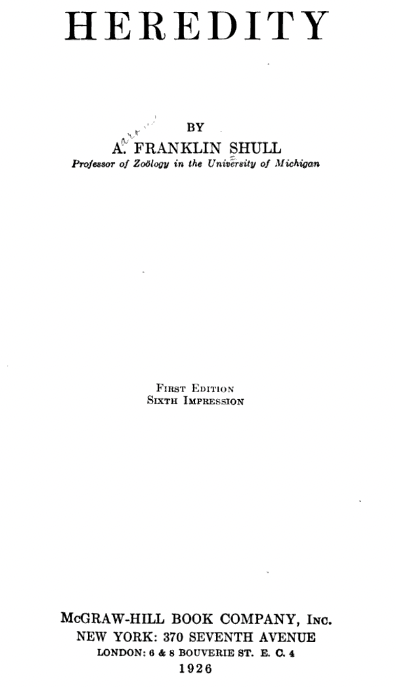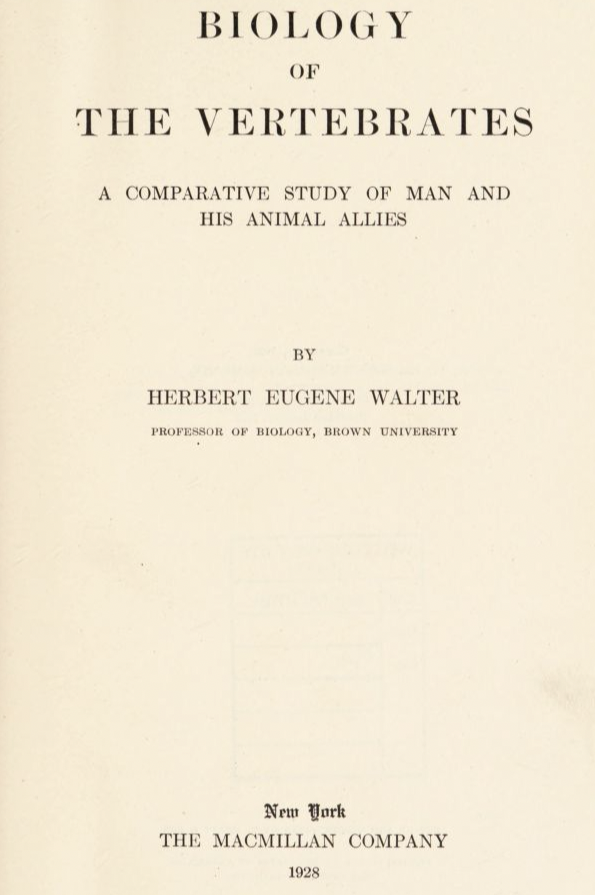
ARCHIVE EXHIBIT 5: Eugenics at Puget Sound
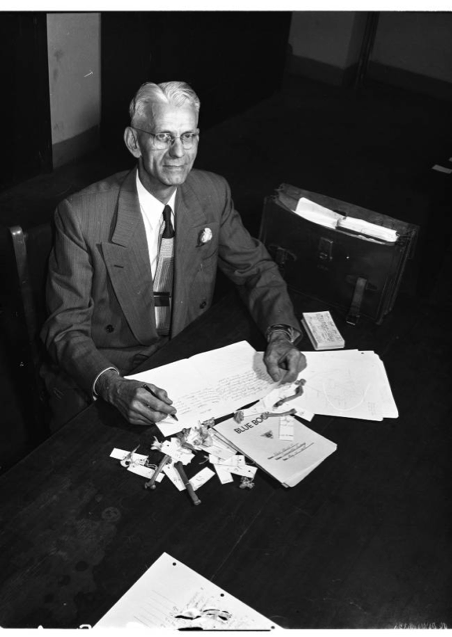
Puget Sound’s eugenics course was taught by Professor James R. Slater, who came to the College of Puget Sound after serving in the U.S. Airforce during World War I. Over more than six decades he helped build the collections of the ‘Puget Sound Museum’, the university’s natural history museum. Today, the museum is one of the most significant natural history collections in the Pacific Northwest. Slater was a popular teacher and in 1979 alumni requested the museum be renamed ‘in honor of his unique service to the institution.’
As Puget Sound’s sole biology professor for many years, Slater taught several courses, including Comparative Anatomy of Vertebrates, Genetics, Entomology, Museum Technique in Biology, Histology & Microscopic Technique, Anthropology, and The Teaching of Biology. No syllabus exists for Slater’s eugenics course. Here archival material, contemporary biology textbooks, and a thesis supervised by Slater, are pieced together to try and determine how Slater may have taught eugenics here at Puget Sound.

Many biologists considered teaching courses on eugenics an important part of a cutting-edge Biology curriculum. Here at Puget Sound, Professor James Slater taught a course on eugenics for three decades As a herpetologist (a zoologist who studies reptiles and amphibians), Slater’s research focused on non-human animals. But as the sole biologist on campus for several years, he presumably viewed a course on eugenics as a crucial component of the biology offerings. The course title and description changed over the years. This is the 1921-1922 version.

By the late 1930s, the title and description had been shortened. “Course 148. Eugenics” was required for all majors and minors in biology, and also required or advised for students majoring in home economics, physical education and sociology. Slater also taught Course 113. Genetics. Slater retired in 1951. The Eugenics course was removed from the bulletin in 1953.
A collection of Lantern Slides used by Slater in various courses offers clues into the textbooks used to prepare for his courses. Here, the book from which Slater took the image is placed below his lantern slides. Henry Fairfield Osborn was the director of the American Museum of Natural History and committed to classifying human beings along a hierarchical, racialized ladder. Aaron Franklin Shull was a zoologist at the University of Michigan, whose view that different species could produce fertile offspring would be criticized by Theodosius Dobzhansky (claims like Shull’s had been used to justify anti-miscegenation laws in the US). Herbert Eugene Walter was a biologist at Brown University. Like virtually all authors of biology and genetics textbooks from the era, each of these authors supported eugenics, and sections on the subject appear in both Shull and Walter’s books. “CREATIVE MEDICINE,” wrote Walter, for example, “which at present is hardly more than a dream, takes a long look ahead and attempts to prevent the abnormal with all its disastrous chain of consequences, by seeing to it that, as far as possible, only the normal are born into the world. This is the hopeful field of EUGENICS, which seeks to lessen and prevent disease by providing an hereditary equipment, able to maintain itself triumphantly harmonious in the face of besetting discords.” (p. 178). Shull discussed eugenics in sections entitled “The Eugenics Movement,” “The Problem of Populations,” and “Race Problems.”
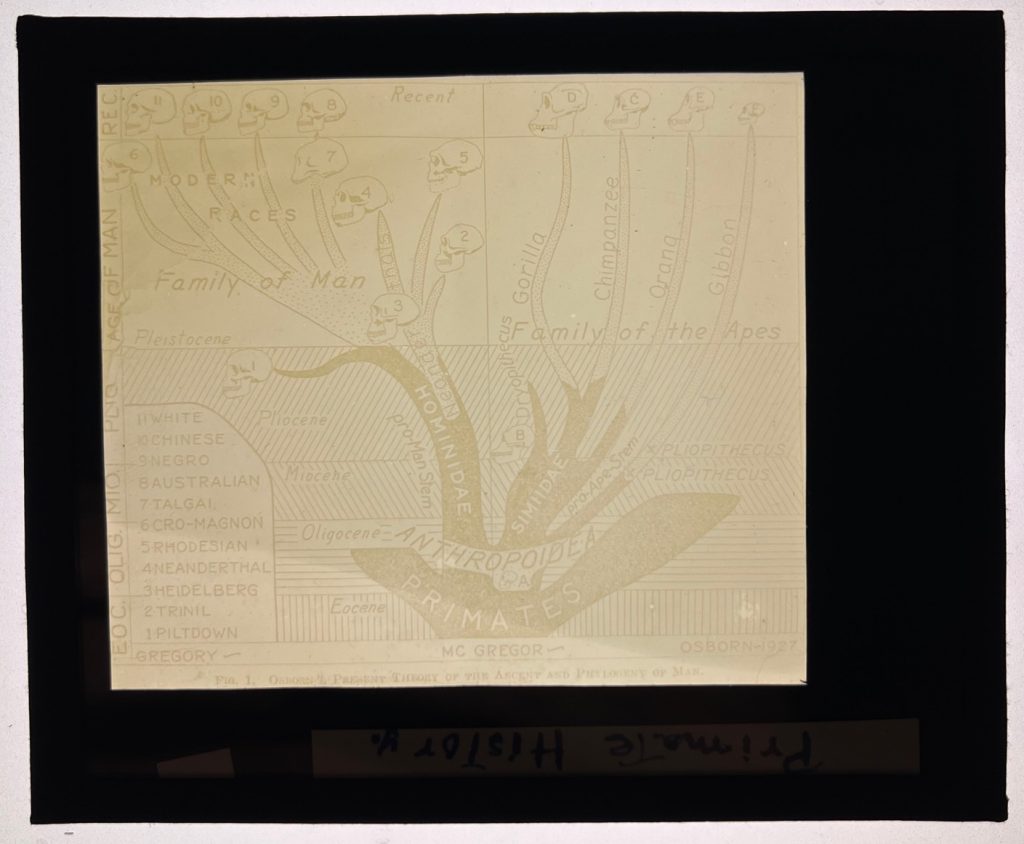
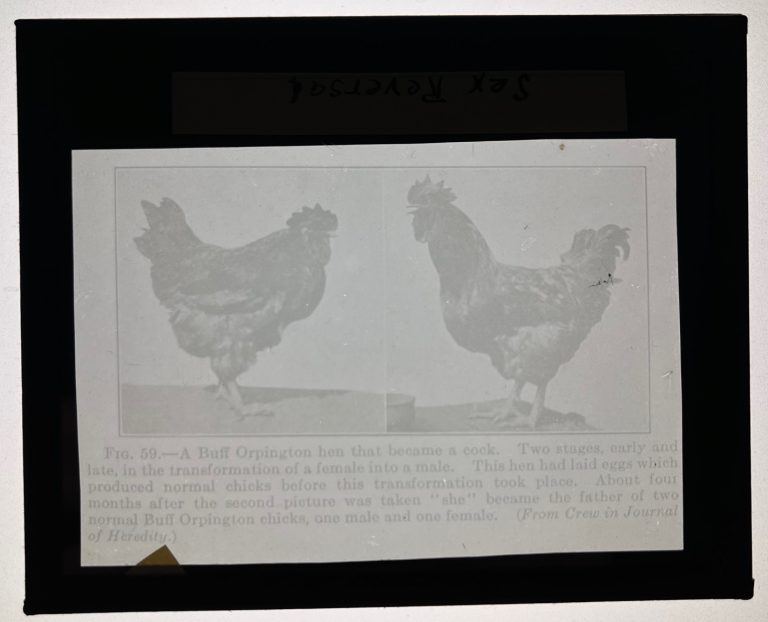
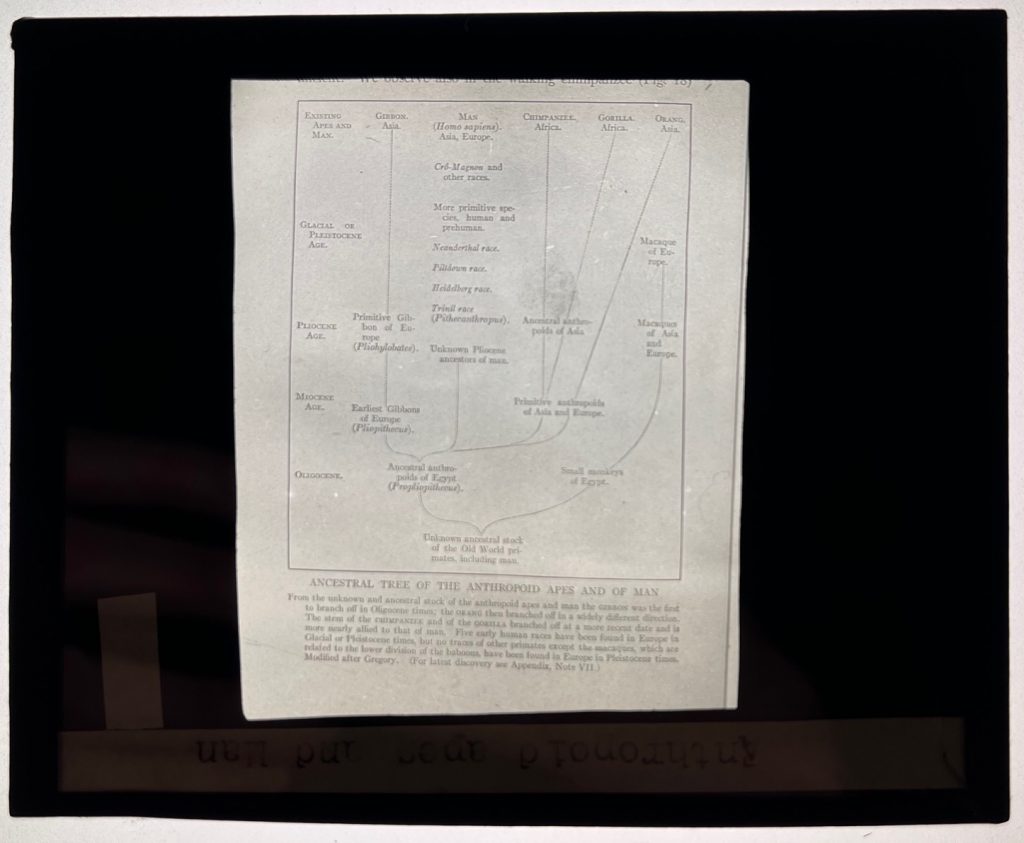
The 1939 Exam Questions for "Eugenics"
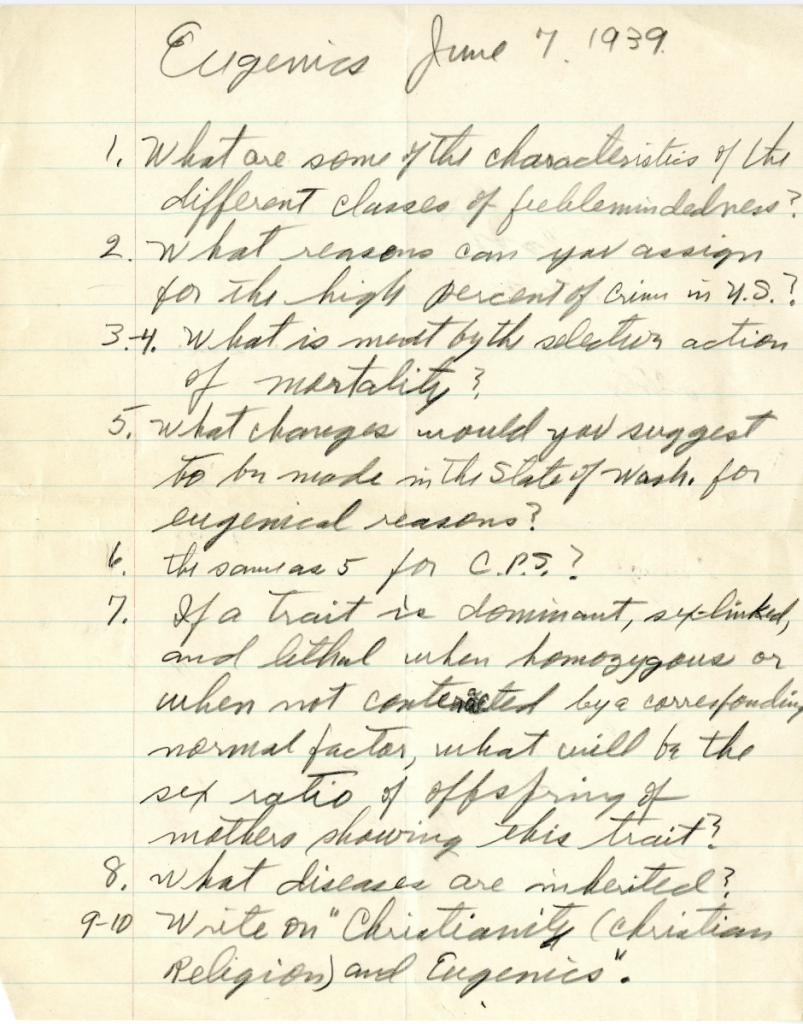
This list of exam questions is from the “James R Slater Papers” housed by Puget Sound’s Archives and Special Collections. They read as follows:
Eugenics, June 7, 1939
1. What are some of the characteristics of feeblemindedness?
2. What reasons can you assign for the high percent of crime in the U.S.?
3-4. What is meant by the selective action of mortality?
5. What changes would you suggest to be made in the State of Washington for eugenical reasons?
6. the same as 5 for the College of Puget Sound?
7. If a trait is dominant, sex-linked, and lethal when homozygous or when not counteracted by a corresponding normal factor, what will be the sex ratio of offspring of mothers showing this trait?
8. What diseases are inherited?
9-10. Write on “Christianity (Christian Religion) and Eugenics.”
To imagine what Slater might have considered correct answers to these questions, contemporary textbooks, articles in Puget Sound’s campus newspaper The Trail, and a thesis supervised by Slater in 1947, were used.
Question #1 What are some of the Characteristics of feeblemindedness?

Harvard geneticist William E. Castle defined feeblemindedness in his influential textbook, Genetics and Eugenics: A Text-book for Students of Biology and a Reference Book for Animal and Plant Breeders (1924) as follows: “all persons congenitally of such low intelligence that they are either unable to care for themselves or are incapable of managing their own affairs with ordinary prudence… Feeblemindedness, according to Goddard, characterizes a large proportion of such persons as become public charges as paupers, drunkards, or criminals.” (p. 352).
Question #2: What Reasons can you give for the high percent of crimes in the US?
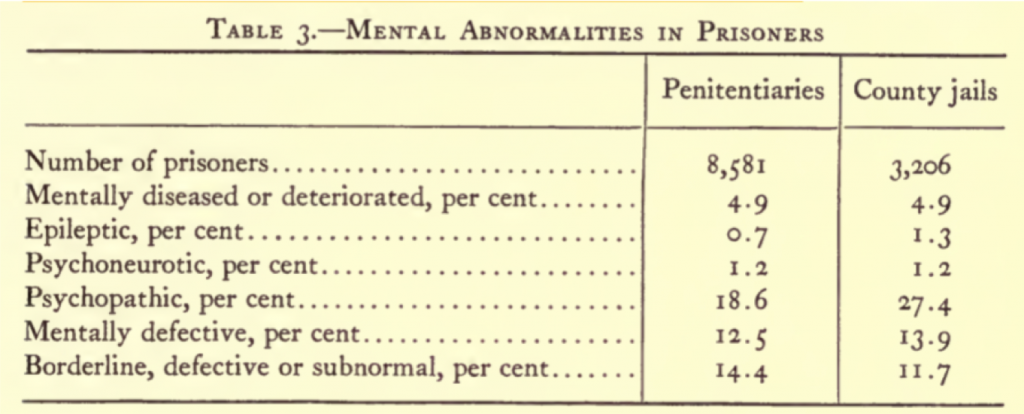
To imagine what Slater might have expected as answers to Questions #2, here are excerpts from University of California, Berkeley professor of zoology S.J. Holmes’ Human Genetics and its Social Import (1936). Slater’s Question #2 appears almost word-for-word in Holmes’ list of questions at the end of the chapter in which this table appears. According to Holmes, 52% of prisoners in Penitentiaries and 60% of prisoners in County jails were “mentally abnormal.”
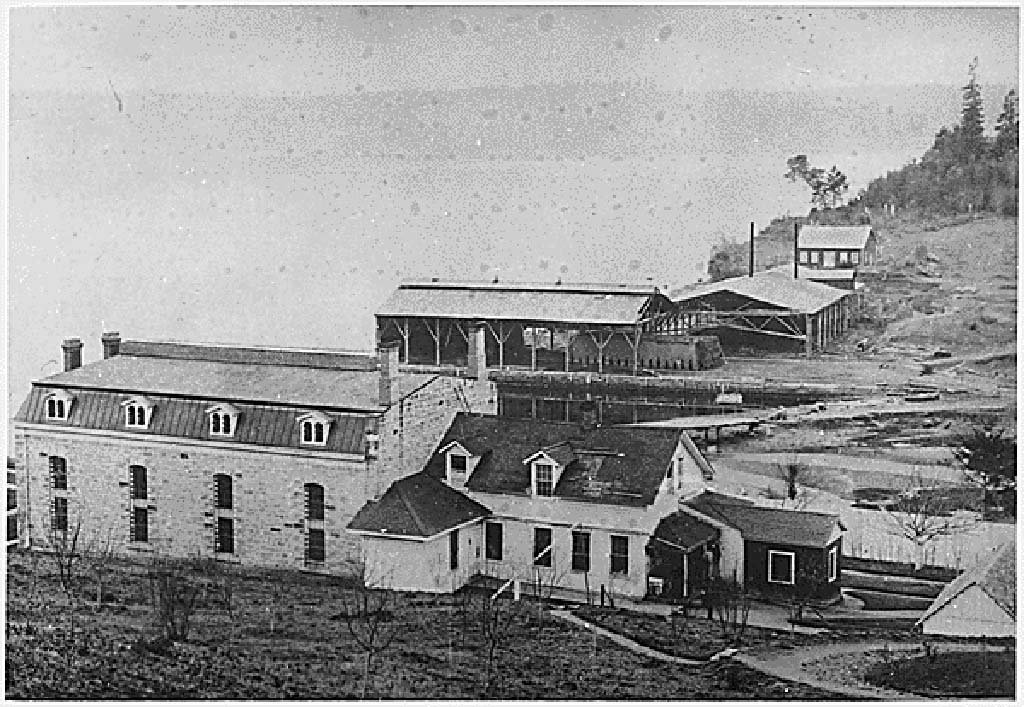
An exchange between Slater and the university chaplain, recorded in the Puget Sound Trail for December 5, 1924 after a visit to McNeil Island Penitentiary (left) hints that some members of the campus community criticized eugenicists’ tendency to blame criminality on heredity. “A question that probably occurred to every mind,” during the visit, noted the student reporter, “was, ‘Why are these men here?’ It was a special phase of the old controversy as to the relative importance of heredity and environment in determining the nature of man. Some of the party heard an interesting argument between Prof. Slater and the chaplain of the penitentiary on the way to the island. The chaplain contended that the prisoners just ‘hadn’t been brought up right,’ while Prof. Slater explained how the different chromosomes conditioned a man’s nature.” The student commented: “Anyone but the most rabid eugenist or cultural determinist will agree that both heredity and environment are potent factors. No one can refute the evidence of the chromosomes, yet it is certain that a man may become good or bad because of his surroundings.” (Image permission pending)
Questions #3-4. What is meant by the selective action of mortality?

In the pages of University of California, Berkeley professor of zoology S.J. Holmes’ Human Genetics and its Social Import (1936), cited above, a discussion of the selective action of mortality (the paragraph on the selective mortality caused by parental intelligence is shown on the left). Holmes then used these claims to express anxiety regarding the ability of advances in medical science to lower the mortality rates of “constitutionally inferior people,”
Question #5. What changes would you suggest be made in the state of Washington for eugenical reasons?
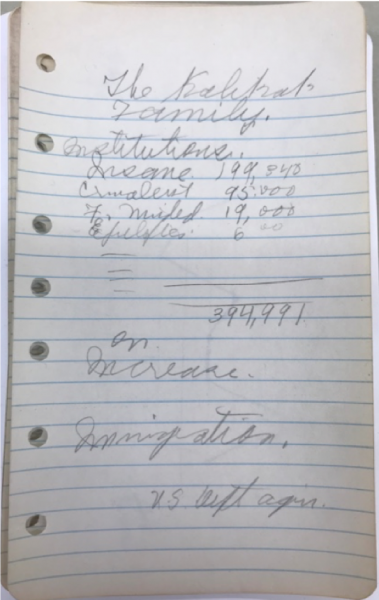
Legislative reform suggested by Aaron Franklin Shull’s textbook on HEREDITY (from which Slater reproduced Lantern Slides) include the following: laws for the sterilization and/or segregation of criminals and other defectives, suitable regulation of marriage and divorce on biological principles, limitation of immigration on the basis of native ability, differential salaries of parents dependent on size and tested mental qualities of families, differential taxation… legalization of proper birth-control information, establishment of eugenics bureaus, and registration of family pedigrees. (Shull, p. 219). (Shull conceded that “to some people, not biologists, interference in matters of sentiment or passion is little short of sacrilege.” p. 244)
This page from Slater’s notebooks mentions “The Kalikak Family,” a famous example often used by eugenicists to illustrate what happened when a ‘fit’ individual mated with an ‘unfit’ individual. The numbers are from a table on page 321 of Brown University biology professor Herbert E. Walter’s textbook Genetics: An Introduction to the Study of Heredity (1925, 2nd edition. First published 1913).
Slater then wrote the words “Immigration” and “U.S. Dept Agri”
The pages of Walter’s textbook from which Slater was taking notes are shown next.

The pages are from Walter’s chapter on “Human Conservation.” Here Walter argues that immigration laws keep “much potentially bad germplasm” out of the United States, and that “It is to be hoped that we, as a nation…” will demand “a knowledge of the germplasm of these candidates for citizenship, as displayed in their pedigrees.” On the subsequent page Walter notes the US Department of Agriculture has field agents scouring every land for desirable animals and plants to introduce, and stringent laws to prevent the importation of “dangerous weeds” and “parasites.” “Is the inspection and supervision of human blood,” he asks, “less important?”
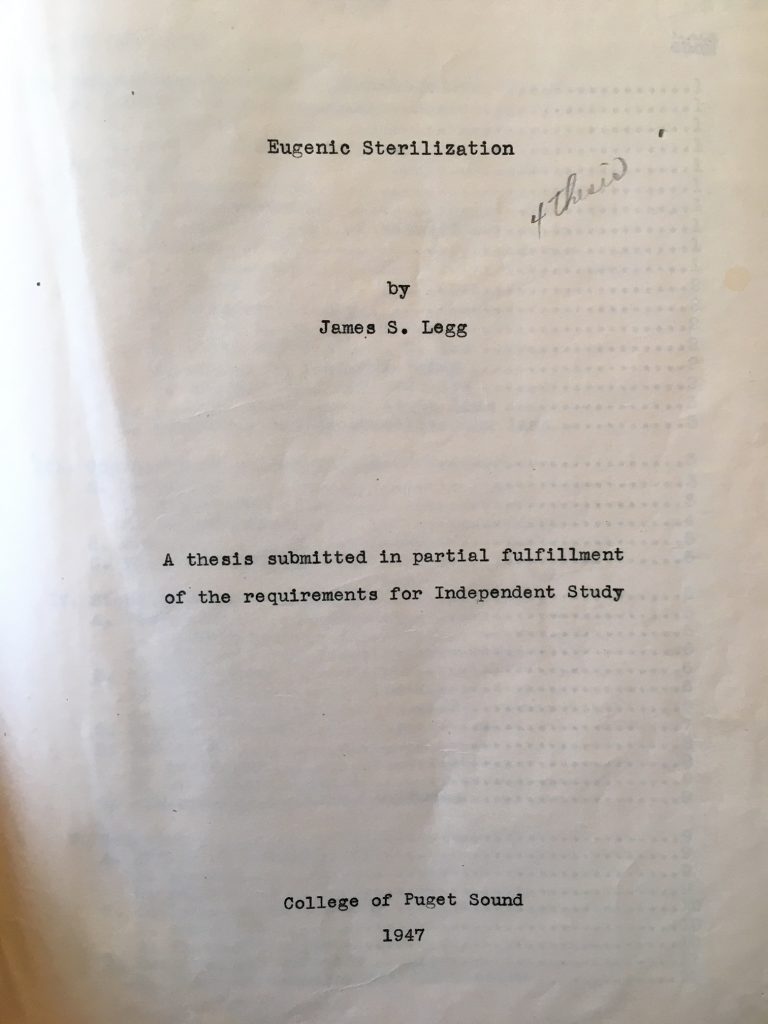

James Legg’s 1947 independent study thesis on “Eugenic Sterilization,” supervised by Slater and composed five years after Washington State’s sterilization laws had been repealed as unconstitutional.
“In the present day,” Legg began his thesis, “when mankind as a whole is striving for human betterment, it is very disconcerting that eugenic sterilization, one of the most necessary means of bringing about this goal, is neglected, forgotten, unknown, discriminated against, or misconstrued by the vast majority of the human race.” Legg cited Paul Popenoe’s book Applied Eugenics extensively, including in his discussion of Supreme Court Justice Oliver Wendel Holmes’ argument to uphold coerced sterilization laws in the 1927 case of Buck v. Bell. Popenoe’s work had a tremendous impact on sterilization laws in California and other states. In his conclusion, Legg lamented the state of Washington’s “present administration” for proving very uncooperative in providing information on past sterilization laws, and criticized a local radio station for refusing to allow a student to speak on the subject.
Question #6. What change would you suggest be made in the College of puget Sound for Eugenical reasons?
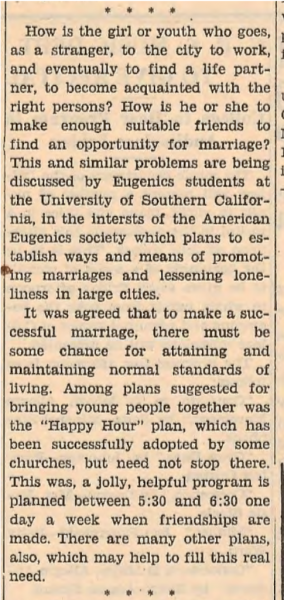
January 17, 1930 The Puget Sound Trail
This article in The Trail – which describes the answers posed by Eugenics students at the University of Southern California – hints at potential answers to Slater’s question: improve the means by which youths can both become acquainted with the ‘right persons’ (via events like ‘Happy Hours’ and presumably with tea rather than cocktails!).
Question #8. What diseases are inherited?

In his 1947 independent thesis, supervised by Slater, biology student James Legg cited a list of inherited diseases from E.T. Bell’s A Textbook of Pathology (1938). Bell’s list included ‘immorality,’ insanity, deafness, and albinism.
Based on his Lantern Slide collection, Slater seemed particularly interested in “Cretinism.” Charles Davenport wrote the following of cretinism (viewed as a common cause of “feeblemindedness”): “That it is hereditary admits of no doubt.” (Heredity in Relation to Eugenics, 1911). (The condition is now called congenital iodine deficiency syndrome and can be treated with iodine supplementation).
Question #9. Write on "Christianity (Christian Religion) and Eugenics
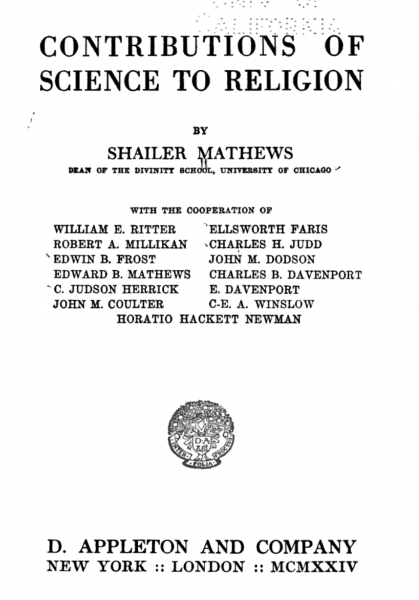
The American Eugenics Society worked hard to ensure Christians that eugenics was not in conflict with faith, including that of denominational colleges like (Methodist) Puget Sound. Charles Davenport, for example, contributed a chapter entitled “Eugenics” to Reverend Shailer Mathews’ influential book The Contributions of Science to Religion (1924).
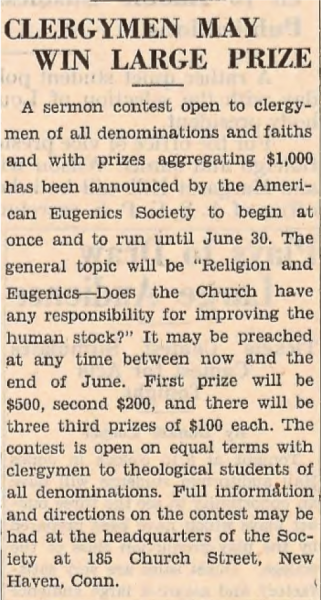
This is an announcement in the Puget Sound Trail that the American Eugenics Society is sponsoring a competition for the best sermon on “Religion and Eugenics: Does the Church have any responsibility for improving the human stock?” (March 14, 1930).
The College of Puget Sound was a Methodist College during the time of Slater’s work. In his independent study thesis ‘Eugenic Sterilization’ (1947) (examined above) Professor Slater’s student James Legg wrote of the relationship between eugenics and Christianity as follows: “It is hardly conceivable that the God of love and mercy whom Christians worship would desire misfits, physical or mental, to perpetuate their misfortunes on to their posterity.” After obtaining Bachelor of Science and Master of Science degrees from Puget Sound, Legg was hired by Whitworth College (in Spokane, Washington) to teach botany and physiology. In June 1948 Legg was described in the Whitworth Bulletin as “having taken a leading part in the religious activities of the various campuses in which he has studied” and “a young man with high ideals who has always been in active sympathy with the program of the church-related college and who is coming to Whitworth because of a keen interest in the program of Christian education.” (Whitworth College Bulletin, Vol 18. No. 2. p. 3).
Eugenics at Puget Sound Compared to Other Colleges and UNiversities
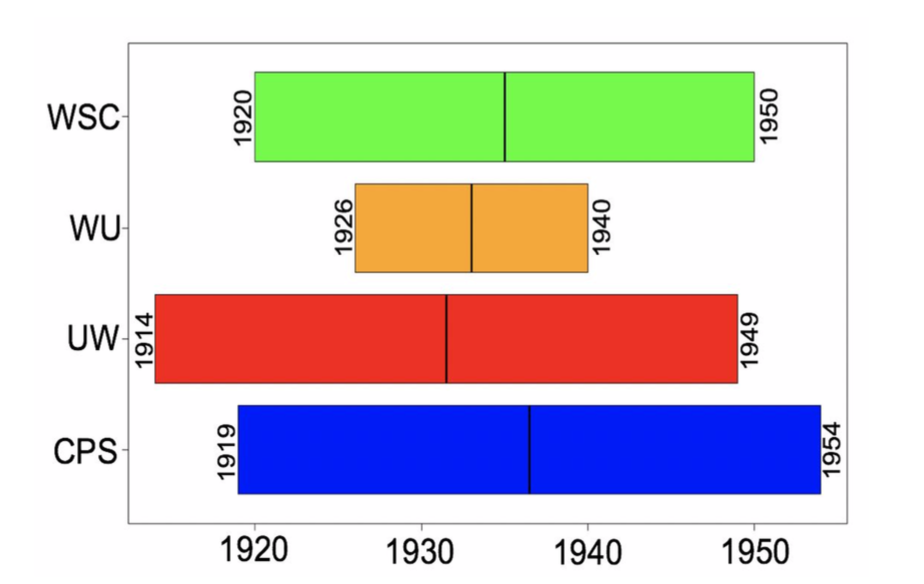
Graph of the time period in which various Washington State colleges and universities offered courses on eugenics.
WSC = Washington State College (now university)
WU = Western Washington University
UW = University of Washington
CPS = College of Puget Sound (now university)
(Courtesy Grace Eberhardt ’20).

